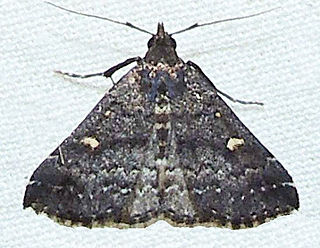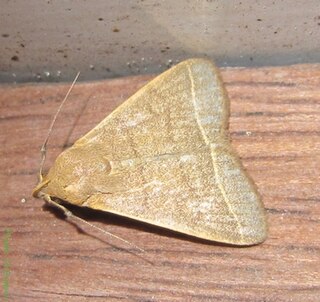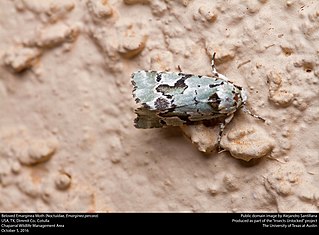
Noctuoidea is the superfamily of noctuid or "owlet" moths, and has more than 70,000 described species, the largest number of any Lepidopteran superfamily. Its classification has not yet reached a satisfactory or stable state. Since the end of the 20th century, increasing availability of molecular phylogenetic data for this hugely successful radiation has led to several competing proposals for a taxonomic arrangement that correctly represents the relationships between the major lineages.

Acontiinae is a subfamily of bird dropping moths in the family Noctuidae. There are more than 50 genera and 430 described species in Acontiinae, found worldwide in temperate and tropical climates.

Amphipyrinae is a subfamily of owlet moths in the family Noctuidae. There are more than 50 genera and 210 described species in Amphipyrinae, although the classifications are likely to change over time.

Idia is a genus of litter moths of the family Erebidae first described by Jacob Hübner in 1813.
Mursa is a genus of moths of the family Erebidae.

Palthis is a genus of litter moths of the family Erebidae. The genus was erected by Jacob Hübner in 1825.

Lascoria is a genus of litter moths of the family Erebidae. The genus was erected by Francis Walker in 1859.

Hypenula is a genus of litter moths of the family Erebidae. The genus was erected by Augustus Radcliffe Grote in 1876.

Udea is a genus of snout moths in the subfamily Spilomelinae of the family Crambidae. The genus was erected by Achille Guenée in 1845. The currently known 216 species are present on all continents except Antarctica. About 41 species are native to Hawaii.

Bleptina is a genus of litter moths of the family Erebidae. It was erected by Achille Guenée in 1854.

Zanclognatha is a genus of litter moths of the family Erebidae. The genus was erected by Julius Lederer in 1857.

Isogona is a genus of moths of the family Erebidae. The genus was erected by Achille Guenée in 1852.

Euxoa is a genus of moths of the family Noctuidae raised to Genus by the German entomologist, Jacob Hübner. The Genus is mostly confined to dry and semi dry areas in the Northern Hemisphere. There 130 species in Eurasia, a few in Africa, and 175 in North America. There are no species in the Genus in South-East Asia or in Australia. In North America, most species are found in Western regions. Of the North American species, 4 are endemic to Mexico. There is one species recorded from Chile, but this may be a mislabeled specimen. In real terms, species numbers do not equal species abundance. Some areas with few species have large numbers of the ones that do live there.

Phalaenophana is a genus of litter moths of the family Erebidae. The species was first described by Augustus Radcliffe Grote in 1873.

Phytometra is a genus of moths of the family Erebidae. The genus was described by Adrian Hardy Haworth in 1809.

Simplicia is a genus of litter moths of the family Erebidae. The genus was erected by Achille Guenée in 1854.

Tetanolita is a genus of litter moths of the family Erebidae. The genus was erected by Augustus Radcliffe Grote in 1873.

The Hypenodinae are a subfamily of moths in the family Erebidae. Adult moths of most species of this subfamily lack small, simple eyes near the large, compound eyes and have quadrifine (four-veined) hindwing cells. The micronoctuid moths are an exception because they possess simple eyes and bifine (two-veined) hindwing cells.

Psaphidini is a tribe of owlet moths in the family Noctuidae. There are at least 40 genera and at least 90 described species in Psaphidini.

Chalcopasta fulgens is a moth in the family Noctuidae. It was described by William Barnes and James Halliday McDunnough in 1912 and is found in North America.



















